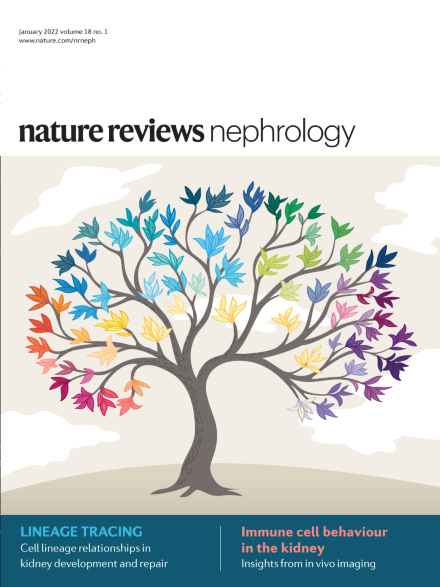A guide to gene–disease relationships in nephrology
IF 28.6
1区 医学
Q1 UROLOGY & NEPHROLOGY
引用次数: 0
Abstract
The use of next-generation sequencing technologies such as exome and genome sequencing in research and clinical care has transformed our understanding of the molecular architecture of genetic kidney diseases. Although the capability to identify and rigorously assess genetic variants and their relationship to disease has advanced considerably in the past decade, the curation of clinically relevant relationships between genes and specific phenotypes has received less attention, despite it underpinning accurate interpretation of genomic tests. Here, we discuss the need to accurately define gene–disease relationships in nephrology and provide a framework for appraising genetic and experimental evidence critically. We describe existing international programmes that provide expert curation of gene–disease relationships and discuss sources of discrepancy as well as efforts at harmonization. Further, we highlight the need for alignment of disease and phenotype terminology to ensure robust and reproducible curation of knowledge. These collective efforts to support evidence-based translation of genomic sequencing into practice across clinical, diagnostic and research settings are crucial for delivering the promise of precision medicine in nephrology, providing more patients with timely diagnoses, accurate prognostic information and access to targeted treatments. The catalogue of genetic factors that have been implicated in kidney disease continues to grow. In this guide to gene–disease relationships, the authors discuss the crucial process whereby genetic and experimental data are critically evaluated to determine whether a genetic variant has a role in kidney disease, which can affect patient diagnosis, prognosis and management.


肾脏病学基因与疾病关系指南
外显子组和基因组测序等新一代测序技术在研究和临床治疗中的应用改变了我们对遗传性肾脏疾病分子结构的认识。尽管在过去十年中,识别和严格评估基因变异及其与疾病关系的能力有了长足的进步,但基因与特定表型之间的临床相关关系的整理却很少受到关注,尽管它是准确解释基因组测试的基础。在此,我们讨论了在肾脏病学中准确定义基因与疾病关系的必要性,并提供了一个批判性评估基因和实验证据的框架。我们介绍了现有的国际计划,这些计划由专家对基因与疾病的关系进行整理,并讨论了差异的来源以及协调统一的努力。此外,我们还强调了统一疾病和表型术语的必要性,以确保对知识进行稳健、可重复的整理。这些支持以证据为基础将基因组测序转化为临床、诊断和研究实践的集体努力,对于在肾脏病学领域实现精准医疗的承诺,为更多患者提供及时诊断、准确预后信息和靶向治疗至关重要。
本文章由计算机程序翻译,如有差异,请以英文原文为准。
求助全文
约1分钟内获得全文
求助全文
来源期刊

Nature Reviews Nephrology
医学-泌尿学与肾脏学
CiteScore
39.00
自引率
1.20%
发文量
127
审稿时长
6-12 weeks
期刊介绍:
Nature Reviews Nephrology aims to be the premier source of reviews and commentaries for the scientific communities it serves.
It strives to publish authoritative, accessible articles.
Articles are enhanced with clearly understandable figures, tables, and other display items.
Nature Reviews Nephrology publishes Research Highlights, News & Views, Comments, Reviews, Perspectives, and Consensus Statements.
The content is relevant to nephrologists and basic science researchers.
The broad scope of the journal ensures that the work reaches the widest possible audience.
 求助内容:
求助内容: 应助结果提醒方式:
应助结果提醒方式:


